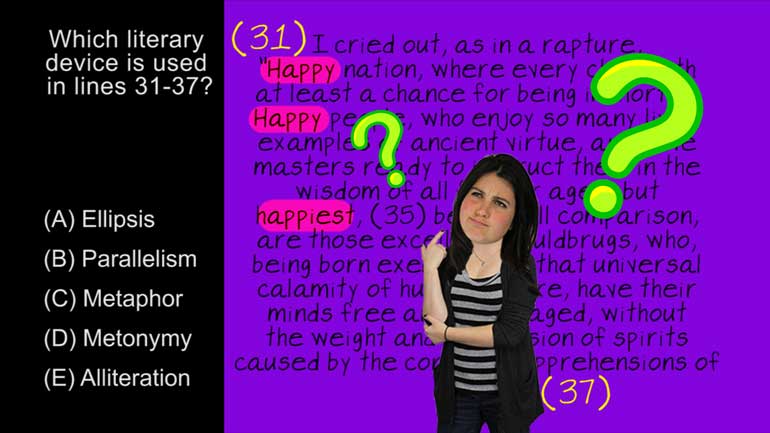ShmoopTube
Where Monty Python meets your 10th grade teacher.
Search Thousands of Shmoop Videos
Physics: Let's Get Moving: Introduction to Acceleration 8 Views
Share It!
Description:
An introduction to acceleration à la Shmoop.
Transcript
- 00:00
smell let's get moving intro to acceleration on acceleration is [writing on chalk board]
- 00:08
velocity into laughs after knowledge direction or future the loss of rep
- 00:13
alright next the acceleration before your very eyes along even in time grass
- 00:17
the grass picture our ups and downs of acceleration ok acceleration it's one of
- 00:30
my favorite things who doesn't want the thrill of putting the pedal to the metal [man in racing car]
Full Transcript
- 00:34
and pee to your seat and it's no surprise to learn that acceleration is
- 00:38
related to velocity so buckle up kids it's time for the only thing more
- 00:43
exciting than the Indy 500 graphs we'll actually get some graphs in a minute [car race]
- 00:50
let's dive deeper into that relationship between velocity and acceleration first
- 00:54
well actually what the heck is acceleration scientifically speaking
- 00:58
acceleration is a description of how an object's velocity is changing over time [writing on chalk board]
- 01:02
and we're going to be looking at uniform acceleration it doesn't mean an [policemen in uniform
- 01:07
acceleration that's dressed in blue and wearing a badge
- 01:10
it means acceleration that stays the same for an extended period of time
- 01:14
like the instant an airplane first revs its engine [airplane on runway]
- 01:17
taking off down the runway it doesn't go from sitting on the runway to flying in
- 01:22
the blink of an eye the engine provides uniform acceleration so the plane picks
- 01:27
up speed second by second until it's fast enough to get airborne or think of [airplane takes off]
- 01:32
a snowboarder at the top of the hill when they first hit the slope they're
- 01:35
barely moving but the acceleration of gravity gets them going faster and
- 01:40
faster until they reach a force of negative acceleration known as a treat [snowboarder hits tree]
- 01:45
yeah uniform acceleration is easier to wrap our minds around and makes the math
- 01:50
easier too an easy math is our favorite kind of math right back the velocity
- 01:55
velocity can tell us how fast we're going at a specific moment in time or [writing on chalk board]
- 01:59
how fast we went in the past like if you're in a car going 40 miles an hour
- 02:04
that's velocity or a turtle crawls from 10 seconds covering one meter yeah and [tortoise walking around]
- 02:09
because it's a vector a quantity that has a value and a direction it also
- 02:13
tells us the direction of that motion well acceleration can tell us how fast
- 02:18
we'll be going in the future it's like having a psychic for speed and since
- 02:23
it's also a vector the direction part is in there too okay so here we go the [psychic with a crystal ball]
- 02:27
velocity equation velocity equals the change in displacement divided by the [writing on chalk board]
- 02:34
change in time think distance over time we've seen this equation before the
- 02:40
equation or acceleration looks pretty similar yeah
- 02:43
see we have to just change couple letters their acceleration equals the
- 02:47
change in velocity divided by the change in time so if the velocity of a biker
- 02:52
starting up his hog changes from zero liters per second to five meters per
- 02:56
second and that change takes place over ten seconds then the bikers acceleration
- 03:01
would be 0.5 meters per second squared and because acceleration and velocity
- 03:07
are related you might think we can just sub in the equation for velocity and
- 03:12
everything would be great but it's not quite that easy because it involves a
- 03:16
calculus yeah all right so here's the equation for acceleration in terms of
- 03:21
displacement acceleration equals two times the quotient of the change in
- 03:25
displacement over the change in time change in time is squared here well this
- 03:30
equation only works when the initial velocity is zero by the way so when you
- 03:34
think initial velocity think some guys sitting on this couch first it kicks [man sitting on couch]
- 03:38
everything off it's not even getting up to grab a bowl of pretzels all right
- 03:43
well before we tackle acceleration versus time graphs let's make sure we [race car driver in rose garden]
- 03:46
have a good handle on a velocity versus time first suppose we're taking our
- 03:50
beloved princess Rigoletto for a walk now the princess prefers a leisurely [race car driver with a pig on a leash]
- 03:55
stroll rather than a vigorous jog so we're covering a meter per second here's
- 04:00
a displacement versus time graph that shows the first 10 seconds of the walk
- 04:04
before princess picolet oh we didn't anyway take a break take a look at this
- 04:10
distance versus time graph we can see here that an object moved 10 meters in
- 04:15
the positive direction over 10 seconds since velocity equals the change in [graph on screen]
- 04:19
displacement over the change in x we can see pretty clearly that the velocity is
- 04:24
1 meter per second and well another way of putting it is that velocity equals
- 04:29
the slop or a slope of this line since slope equals rise over run which is the
- 04:35
change in the y-axis over the change in the x axis in this case the y axis is
- 04:41
displacement and the x axis is time and since this is a straight line we can
- 04:46
also see that the velocity is constant well this object doesn't speed up or
- 04:51
slow down in its little journey here it keeps right on going at the same
- 04:54
speed so what would our velocity versus time graph look like
- 04:58
well it'd look like this one nice and flat some might even say boring so what
- 05:03
does this graph tell us about our Piggy's acceleration well remember
- 05:06
acceleration is the change in velocity over time does the velocity change nope
- 05:11
not one bit there is no acceleration the pig is on cruise control just cruising
- 05:17
along no accelerating well that's no fun and like I've been talking about
- 05:21
acceleration this whole time Paul and our [pig sits down]
- 05:23
Graff has none at all alright let's take care of that here's another displacement
- 05:27
versus time graph what is this graph telling us well for one thing that it's [graph on screen]
- 05:31
happy but more importantly it says that we've got something that starts at the
- 05:35
zero position move 25 meters in the negative direction then it comes back
- 05:39
moving in the positive direction when would this happen well let's say you
- 05:43
want to have a little game of catch but all your friends are busy doing lame [family playing piano together]
- 05:46
stuff like you know spending time with their family or studying
- 05:50
look friends are the word but there's a solution it's boomerang time yes the
- 05:55
boomerang the perfect outdoor toy for the anti-social trust us we've been [man playing with a boomerang]
- 05:58
there that we started shmoop on a graph we know we have motion and we know the
- 06:03
slope isn't constant that's definitely not a straight line well what does this
- 06:07
mean about the velocity well the object slows down for the first 5 seconds
- 06:11
eventually coming to a stop then on its return trip it picks up speed so the [graph on screen with boomerang]
- 06:16
velocity isn't constant either now let's start by figuring out this whole
- 06:19
velocity thing well start it one second right there remember to find the
- 06:24
instantaneous velocity the velocity at any one point in the time span we have
- 06:28
to look at the displacement at the moment right after our target second and
- 06:33
from that we'll subtract the displacement from the moment right
- 06:36
before oh it's dark net second one rather than second zero because we
- 06:40
started at second zero we have to look at second one and second negative one
- 06:44
sadly there was no way to go back in time even for a second so that wouldn't
- 06:48
work out very well would it the displacement at second two is negative
- 06:52
16 meters that second zero the displacement is zero instantaneous
- 06:56
velocity is an average well the change in time we're looking at is two seconds [writing on chalk board]
- 07:01
and the change in displacement is negative 16 meters so a second one the
- 07:05
velocity is negative eight meters per second let's plot that on our graph
- 07:09
right there all right now let's look at the velocity at the second second or
- 07:14
second two and that's less confusing and we'll do the same thing subtracting the
- 07:18
displacement at second three which is negative 21 meters from the displacement
- 07:23
from second one which is negative nine meters giving us a change in
- 07:27
displacement of negative 12 meters and a change in time of two seconds making the
- 07:32
velocity negative meters-per-second here and we can pop
- 07:35
that onto our graph well we can do this all day but we won't make you listen to
- 07:39
us plot each and every point and I will still look we'll still do it later for
- 07:44
fun but you won't have to listen to it eventually we have a velocity graph that
- 07:49
looks like this oh and how do we graph the velocity from second zero to second
- 07:54
one well this is a straight line and there's no reason to think that
- 07:56
something crazy happened during that first second to knock this line off its
- 08:00
path so we can just extend it back to be a zero point like so so what does this
- 08:05
velocity graph tell us well it tells us that the boomerang started off quickly
- 08:09
in the negative direction slowed down stopped for a moment then started back
- 08:13
in the positive direction getting faster pretty much the same thing as a
- 08:16
displacement graph which makes sense since they're related at all but what
- 08:20
does this graph tell us about acceleration remember acceleration is
- 08:24
the change in velocity over the change in time our final velocity is 10 meters [writing on chalk board]
- 08:29
a second and our starting velocity was negative 10 meters a second making the
- 08:33
total change 20 meters a second and that was over a 10 second period which makes
- 08:38
the acceleration 2 meters per second per second or to put it another way 2 meters
- 08:43
per second squared it might seem a little weird that even as this object is
- 08:48
slowing down its acceleration is staying the same
- 08:51
it might help think of gravity gravity is a constant force of acceleration
- 08:56
negative 9.8 meters per second squared well let's say we're throwing a ball
- 09:01
straight up in the air why because everyone gets bored sometimes even [race car driver hits ball up into sky]
- 09:04
racecar drivers once the ball leaves our hand the acceleration of gravity starts
- 09:08
working right away it slows the ball down and sends it back down our way so
- 09:13
the ball speed and velocity are changing but the acceleration of gravity is not
- 09:17
when we had a displacement graph that was linear that meant the velocity was [graph on screen]
- 09:22
constant resulting in a graph that had no slope nothing a dead man's balls and
- 09:27
the same thing applies between velocity graphs and acceleration graphs if a
- 09:32
velocity versus time graph is linear like this one the acceleration graph
- 09:36
that goes along with it will also be flat and we can tell if acceleration is
- 09:41
positive or negative by looking at the slope of the velocity graph
- 09:44
if a slope of the velocity line is positive the acceleration is positive if
- 09:48
the slope is negative well yep so is the acceleration
- 09:51
now you might have heard the term deceleration somewhere maybe in some
- 09:55
sci-fi movie with giant ants we're gonna ask you to do us a favor forget that
- 09:59
word at least when you walk into your science class in physics there's no such
- 10:03
thing as deceleration acceleration is a vector quantity which means it can be
- 10:09
positive or negative but just because an object has a negative acceleration [writing on chalk board]
- 10:13
doesn't mean it's slowing down it depends on its direction if an object
- 10:18
has velocity in the negative direction and negative acceleration well that
- 10:22
means the object is speeding up but velocity in the positive direction and
- 10:26
negative acceleration yeah that means it's slowing down as does velocity in
- 10:31
the positive direction and negative acceleration and if both the direction
- 10:34
of velocity and acceleration are positive it means that the object is
- 10:39
speeding up as it goes along well to boil it down of the directional velocity
- 10:42
and the acceleration share the same sign whether positive or negative it means
- 10:46
the speed is increasing if they conflict with one plus and the other minus this
- 10:52
means the object is slowing down yeah you might notice that we haven't
- 10:56
actually seen an acceleration versus time graph don't don't worry we've got
- 11:00
plenty of those coming up just not in this lesson it's more important for now [man racing in a car]
- 11:03
that you understand how velocity and acceleration are related when we step on
- 11:08
the gas pedal our rate of velocity changes say we have a constant
- 11:12
acceleration of five meters per second squared
- 11:14
five seconds into this motion we're covering 25 meters a second not bad
- 11:18
that's about 56 our there but after 15 seconds of this
- 11:23
constant acceleration but we're traveling 75 meters a second
- 11:27
that's almost 168 miles an hour which just might win us a race or get us a
- 11:33
ticket [race car gets pulled over by police]
Up Next
When you're about to marry the love of your life, not many things could stop you. However, finding out that your future hubby is keeping his crazy...
Related Videos
Here at Shmoop, we work for kids, not just the bottom line. Founded by David Siminoff and his wife Ellen Siminoff, Shmoop was originally conceived...
ACT Math: Elementary Algebra Drill 4, Problem 5. What is the solution to the problem shown?
AP® English Literature and Composition Passage Drill 1, Problem 1. Which literary device is used in lines 31 to 37?
AP® English Literature and Composition Passage Drill 2, Problem 1. What claim does Bacon make that contradicts the maxim "Whatsoever is delig...




